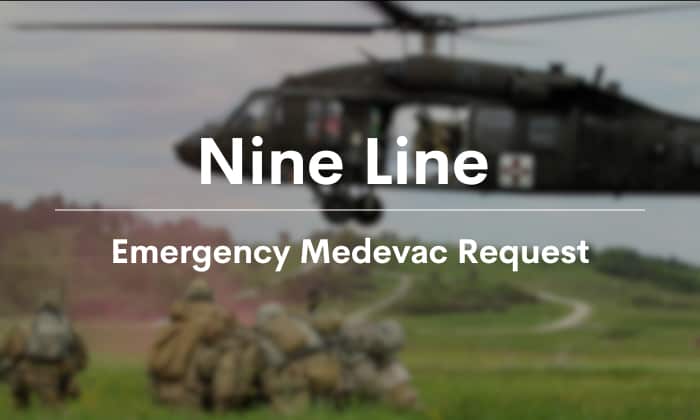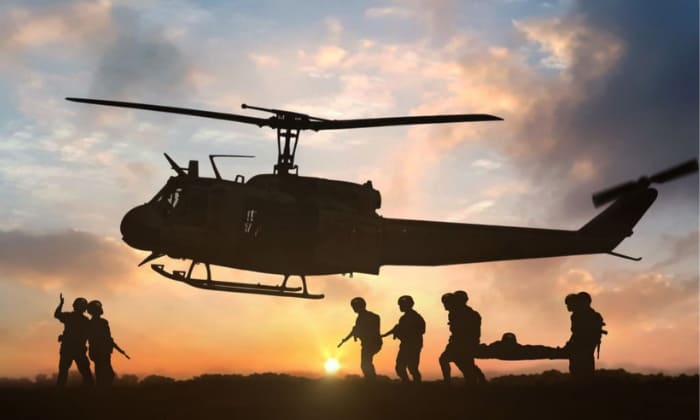Have you ever considered what the military does to enable peace? While we bask in the beauty of our surroundings, it’s significant to acknowledge the hidden story.
Understanding what does nine line mean in military terms sheds light on their sacrifices. When soldiers sustain injuries in combat, they rely on the military nine-line to call for crucial medical assistance. It serves as the army’s equivalent of asking for help from their own 911, enabling them to receive timely medical care.
Table of Contents
Definition of “Nine Line” in Military Terms
In the heat of combat, soldiers require essential provisions like food, water, and critical medical assistance. Before entering the battlefield, it is crucial to possess relevant knowledge, such as understanding nine line meanings in military terms.
The 9-line meaning signifies the protocol for requesting an emergency medevac, serving as a critical lifeline.
For gravely injured troops, it becomes the defining factor between life and death. This crucial communication ensures prompt access to medical aid, playing a pivotal role amid combat.
The Origin and History of the Term
- Tracing the history and origins of the nine line, it all started with medevac, the concept of medical evacuation.
Early in the 19th century, during the war, two notable surgeons, Barons Dominique Jean Larrey and Pierre Francois Percy, played pivotal roles in designing the initial effective systems for medical evacuation.
Their plans included moving the injured from the front lines to mobile field hospitals with small, horse-drawn carts, allowing immediate surgical care.
- The United States Army Medical Department in Florida tested horse-drawn ambulances and advised the military to use them at the time of the Seminole War. However, it was unfortunate that they did not receive any feedback or follow-up.
- It was amidst the Franco-Prussian War that the inaugural instance of aeromedical evacuation took place. As part of this historical event, observation balloons ascended from the city, carrying numerous mail bags, a handful of high-ranking officials, and 160 injured individuals.
- After a considerable period, two army officers, George H.R. Gosman and Lt. Albert L. Rhoades, embarked on a self-funded endeavor to construct a peculiar aircraft intended for use as a medical evacuation vehicle.
Regrettably, during its inaugural flight, the aircraft met an unfortunate fate and crashed into a tree. As a result of both the mishap and the perceived impracticality of the project, the decision was to discontinue further development.
- Following that incident, numerous years elapsed, and advancements in air vehicles persisted. These advancements paved the way for helicopters as the primary means of conducting medical evacuation services.
- In the context of medevac, it is noteworthy that medevac teams often face challenges in obtaining accurate and comprehensive information when soldiers request assistance.
It is particularly true for operations carried out overseas or in highly restricted areas, where pinpointing the exact location of troops can be problematic due to insufficient details.
Furthermore, there is a lack of proper classification regarding the types of injuries, leading to situations where even minor non-life-threatening injuries prompt medevac calls, resulting in the unnecessary allocation of resources.
- Eventually, recognizing the challenges by combatants in requesting assistance, the military and surgeons collaborate to address this issue.
They developed and consistently refined a specialized reporting system, the 9 line report. This format significantly enhanced the efficiency of reporting life-threatening cases during combat situations.
The effectiveness of the nine line format became increasingly evident, emerging as the optimal method for calmly and accurately communicating a soldier’s need for immediate medical attention.
- Henceforth, the term “nine line” came into existence as a direct result of these developments and the implementation of the standardized reporting system.
Purpose of a Nine Line
1. Communication
The nine-line request holds significant importance as it is a transmitting tool that passes essential data over the radio, the internet, or other communication channels.
This information plays a crucial role in organizing the transfer of the injured and preparing them for evacuation.
As we consider that the person coordinating the evacuation may not accompany the wounded during the voyage, conveyed details must be accurate to various parties involved, from the initial call for evacuation until the mission is declared accomplished.
Adherence to the nine-line format becomes essential as it establishes a uniform way of communicating critical patient and mission information, ensuring the efficiency and effectiveness of the medical evacuation procedure.
2. Nine-line apparel
Going forward, there exists a foundation dedicated to the creation of Nine Line Apparel, whose mission mirrors the concept of the military’s nine-line system.
The distinction between the foundation and the military medevac lies in their objective to aid wounded veterans in rebuilding and enhancing their overall quality of life.
The foundation’s goal is to uplift the lives of veterans who have been saved through medevac operations.
The apparel features a distinctive design, showcasing the nine line sticker and a helicopter decal, symbolizing their support for these veterans.
Components of a Nine Line
In military and emergency medical situations, the 9-line acronym provides a fast and effective way to communicate crucial information about casualties and medical evacuations, ensuring efficient reporting of injured troops.
To gain a better understanding of the 9-line request format, please refer to the chart provided below.
| Nine-Line Medevac Request Format | |||
| Line # | Equivalent in Words | Meaning | Standard Codes |
| Line 1 | Pick-up location address
|
Providing the latitude and longitude coordinates to identify the specific site
|
Longitude
Latitude coordinates |
| Line 2 | Radio frequency
|
Code that defines the channel or can be fragmented to elude enemy tracking. | Frequency
Call sign Suffix |
| Line 3 | Patient count based on priority | For instance, you relay the number of how many urgent patients, urgent surgical, routine, priority, or convenience.
|
A – Urgent
B – Urgent Surgical C – Priority D – Routine E – Convenience |
| Line 4 | Medical Equipment
|
The supplies that the medevac will bring can include essential items such as ventilators, extraction tools, or none, depending on the specific requirements of the situation.
|
A – None
B – Hoist C – Extraction Equipment D – Ventilator |
| Line 5 | Total # of patients
|
The total # of patients for the medevac mission depends on the count of ambulatory or litter patients present | A – Litter (requiring a stretcher)
B – Ambulatory (able to walk) |
| Line 6 | Security at the pick-up location
|
To determine whether the site is secure, or the Medevac team requires an escort.
|
N – No enemy troops in area
P – Possible enemy troops in area E – Enemy troops in area X – Enemy troops in area |
| Line 7 | Method of marking pick-up site
|
It involves either signalling devices or markings in the surrounding area. | A – Panels
B – Pyrotechnic signal C – Smoke signal D – None E – Other |
| Line 8 | Status and Nationality of Patient
|
Categorized as either belonging to the US community or troops, other nationalities, civilians, enemy prisoners, or other classifications as necessary.
|
A – US Military
B – US Civilian C – Non-US Military D – Non-US Civilian E – EPW |
| Line 9 | NBC Contamination
|
It is the potential risks of contamination or exposure that the medevac team may encounter during transport. It includes the possibility of biological, nuclear, or chemical hazards.
|
N – Nuclear
B – Biological C – Chemical |
Examples of Situations Where a Nine Line Would Be Used
We provide you below some examples of the medevac scenarios for training purposes.
Scenario 1: An enemy prisoner of war trapped in a chemical leak event, experiencing respiratory distress and needing immediate evacuation to a medical institution.
Scenario 2: A soldier with severe chest injuries requires immediate transportation to a secure medical facility.
Scenario 3: Several civilians were hit by an improvised explosive device (IED), leading to casualties requiring extraction and medical evacuation.
Feel free to review this video sample demonstrating the process of requesting a medevac.
Conclusion
To summarize, the article explains what does nine line mean in military terms and its significance. It focuses on requesting a nine-line medevac, particularly in combat situations where soldiers may suffer severe injuries necessitating urgent medical attention and evacuation to the nearest medical facility.

For an ex-serviceman, it is a pleasure for me to continue my work in The Soldiers Project. This site is built with the target to help people who work in security jobs and other people to gear themselves with high-quality equipment. It is essential for many duties that they have the protection required to perform with safety.




